

Zoomorphic and Anthropomorphic Types
![]()
![]()
We are faced each day with iconic images. The majority of the time, we do not know how their meanings affect on our thought processes. We do not know why we shy away from certain iconic images and are frightened and cry and think of God or family when we see others. Image is everything. Image tell a story. Image is a representation or icon of something. An iconic image informs us of something or translates a message we can't completely understand in a sentence or at a glance. It is a book written by our ancestors. Zoomorphic and Anthropomorphic image unlike a simple picture or phrase is set up to speak volumes and volumes of knowledge.
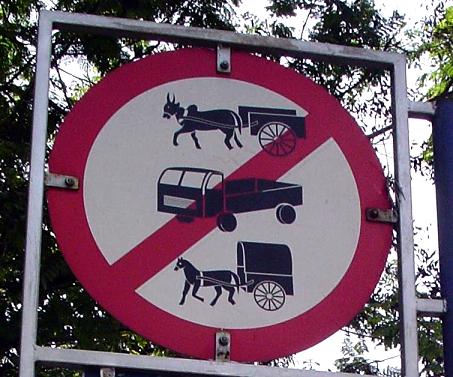
Here is a simple sign photographed in India. On the sign there is a donkey cart, a truck, and a horse dawn carriage all in a red circle with a line drawn thought the center. This symbol, type, iconic image or representation is informing the reader, that those three types of transportation are not allow in the area. You don't need to understand Hindi to decipher the message, you don't even need to know how to read, because the message is universal. The sign is something everyone can understand.
Just as this image, sign tell us important information, it is true for very other image, icon and representation. If you need to understand more on symbolism and iconography I have written essays on those topics and I suggest you read them, please follow the links.
Zoomorphic types: We can see from this word there are two Greek words in it Zoo+morphic. I know this may be simplistic, but is the best route of explanation. Zoo meaning animal and Morph meaning shape. Zoomorphism is the act of attributing animal characteristics to non-animal things.
(Rev. 5:5:) "Do not weep! See, the Lion of the tribe of Judah, the Root of David
has triumphed. He is able to open the scroll and the seven seals"
An example of this is the symbol of the Jewish Judah or Yehuda.
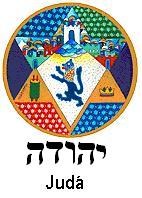
The symbol for the Lion is in the
center of the triangle or star of David, and the Ethiopian rendition of the same
iconic title: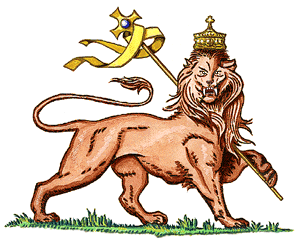 Both are used as Zoomorphic types or the act of attributing animal
characteristics to non-animal things.
Both are used as Zoomorphic types or the act of attributing animal
characteristics to non-animal things.
Why use animals? Simply because it is a good way to describe the indescribable and man was closer to nature then, unlike today we are wrapped up into technology and now we use technological icons, but they all relate back to the foundation of zootype and anthropomorphic types. Both images tell a story if you understand the basic imagery. Judaistically speaking, the image is of a nation. Christianity uses it as an image for Jesus. Are they worshipping a animal? Of course not!
Now, let us move on to the next word: Anthropomorphism. Anthropos+ morphus another Greek word means: The attribution of uniquely human characteristics and qualities to nonhuman beings, inanimate objects, or natural or supernatural [beings] phenomena. Anthropos means human, and morphos means shape.
How many time have you given your pet a human name? How man of have named out car, bicycle and body parts [OK men you know what I mean] name? We all do it. How many times have we cooked a Turkey and asked "Is he ready yet?" What about your children relating to Mickey Mouse, Kermit the Frog, Elmo and Ms. Piggy? Well, that's Anthropomorphism! One of my favorite songs is by Kermit. It's not easy being Green. Jim Henson, god rest his soul was taking about racism, sexism and all other "ism" that make a person marginalized in the eyes of other and in their own eyes. and he sis this through Kermit.
It's not that easy being
green;
Having to spend each day the color of the leaves.
When I think it could be nicer being red, or yellow or gold...
or something much more colorful like that.
It's not easy being green.
It seems you blend in with so many other ord'nary things.
And people tend to pass you over 'cause you're
not standing out like flashy sparkles in the water
or stars in the sky.
But green's the color of Spring.
And green can be cool and friendly-like.
And green can be big like an ocean, or important like a mountain,
or tall like a tree.
When green is all there is to be
It could make you wonder why, but why wonder why?
Wonder, I am green and it'll do fine, it's beautiful!
And I think it's what I want to be.
Cute song--huh? Ok, thanks for that indulgence. It was a FROG telling a story to get all kids to see a cardinal point; be happy with who you are. You are beautiful! Now, that's Zoomorphism in the 21st century. A Frog giving us a life lesson!
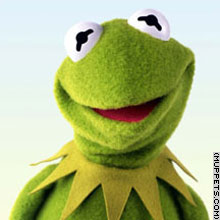
Now that we have our definitions down, let's look at a few ancient version of Zoo and anthropomorphism. Remember the premise:
"We are faced each day with iconic images. The majority of the time, we do not know how their meanings affect on our thought processes. We do not know why we shy away from certain iconic images and are frightened and cry and think of God or family when we see others. Image is everything. Image tell a story. Image is a representation or icon of something. An iconic image informs us of something or translates a message we can't completely understand in a sentence or at a glance. It is a book written by our ancestors. Zoomorphic and Anthropomorphic images unlike a simple picture or phrase is set up to speak volumes and volumes of knowledge. "
We have been told for years that we, as Africans living in Africa and the Diaspora, were pagans and we needed saving. When Africa was explored by missionaries it was called the dark continent. Not just because of our skin color because we varied in that, but because of the unknown, mystery and fear Africa came to mean in the hearts of those who deemed themselves enlightened and educated. We could open up the discussion that Europe became enlightened each time they touched the black lands by way of commerce, education or invasion, from the Greeks begging to go to school in Egypt, to the Moorish invasion of the Iberia, even until Europe's so-called age of Enlightenment, but that is a story for another essay.
The basis of this fallacy in believing our people were pagans has a root in what the secondary scholars wrote about our images. The primary scholars that initially wrote about us did not see through the lens of paganism. the secondary scholars who had designs on Africa our people, history and natural resources coined the destructive terms we now take for granted, savage, pagan, ignorant natives. With the propagation of the new religions of the world based in a European construct, the die was cast and a jaundiced eye was used when viewing and analyzing anything from African.
We must now go back and study our images with an honest assessment that leads to understanding and not with ignorance, fear and condemnation.
Why are we afraid of our own History?
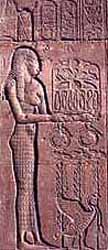
Neith
Here is an excerpt from:
Ethiopia and the Origin of Civilization--A Critical Review of the Evidence of Archaeology, Anthropology, History and Comparative Religion: According to the Most Reliable Sources and Authorities, By John G. Jackson (1939).
"It seems certain,” declares Sir E. A. Wallis Budge, “that classical historians and geographers called the whole region from India to Egypt, both countries inclusive, by the name of Ethiopia, and in consequence they regarded all the dark-skinned and black peoples who inhabited it as Ethiopians. Mention is made of Eastern and Western Ethiopians and it is probable that the Easterners were Asiatics and the Westerners Africans.” (History of Ethiopia, Vol. I., Preface, by Sir E. A. Wallis Budge.) In addition Budge notes that, “Homer and Herodotus call all the peoples of the Sudan, Egypt, Arabia, Palestine and Western Asia and India Ethiopians.” (Ibid., p. 2.)
Herodotus wrote in his celebrated History that both the Western Ethiopians, who lived in Africa, and the Eastern Ethiopians who dwelled in India, were black in complexion, but that the Africans had curly hair, while the Indians were straight-haired. (The aboriginal black inhabitants of India are generally referred to as the Dravidians, of whom more will be said as we proceed.)
Another classical historian who wrote about the Ethiopians was Strabo, from whom we quote the following: “I assert that the ancient Greeks, in the same way as they classed all the northern nations with which they were familiar as Scythians, etc., so, I affirm, they designated as Ethiopia the whole of the southern countries toward the ocean.”Strabo adds that “if the moderns have confined the appellation Ethiopians to those only who dwell near Egypt, this must not be allowed to interfere with the meaning of the ancients.”
Ephorus says that: “The Ethiopians were considered as occupying all the south coasts of both Asia and Africa,” and adds that “this is an ancient opinion of the of the Greeks.”
Then we have the view of Stephanus of Byzantium, that: “Ethiopia was the first established country on earth; and the Ethiopians were the first who introduced the worship of the gods, and who established laws.” The vestiges of this early civilization have been found in Nubia, the Egyptian Sudan, West Africa, Egypt, Mashonaland, India, Persia, Mesopotamia, Arabia, South America, Central America, Mexico, and the United States.
In discussing the origin of civilization in the ancient Near East, Professor Charles Seignobos in his History of Ancient Civilization, notes that the first civilized inhabitants of the Nile and Tigris-Euphrates valleys, were a dark-skinned people with short hair and prominent lips; and that they are referred to by some scholars as Cushites (Ethiopians), and as Hamites by others.
“It is pretty well settled that the city is the Negro’s great contribution to civilization, for it was in Africa where the first cities grew up.” E. Haldeman-Julius
“Those piles of ruins which you see in that narrow valley watered by the Nile, are the remains of opulent cities, the pride of the ancient kingdom of Ethiopia. … There a people, now forgotten, discovered while others were yet barbarians, the elements of the arts and sciences. A race of men now rejected from society for their sable skin and frizzled hair, founded on the study of the laws of nature, those civil and religious systems which still govern the universe.” Count VolneyIn Book II, Section-104, of his celebrated History, Herodotus states: “For my part I believe the Colchi to be a colony of Egyptians, because like them they have black skins and frizzled hair.”
Diodorus, Book I, [28, 1-4]speaks of the land of Moab.
". . . that the nation of the Colchi in Pontus and that of the Jews, which lies between Arabia and Syria, were founded as colonies by certain emigrants from their country [Egypt]; and this is the reason why it is a long-established institution among these two peoples to circumcise their male children, the custom having been brought over from Egypt."
Yes, this was written in 1939 the age of enlightenment in America and especially among our people. We reject our noted scholars for the views of modern writers, but that is a terrible decision. Wisdom sits in the libraries of the world and is brought to the light by honest scholarship.
Just what are we afraid of?
What is fear? A feeling of agitation and anxiety caused by the presence or imminence of danger or to be uneasy or apprehensive. We have been taught to fear ourselves and our history and then categorize our images as evil and demonic. They are not!
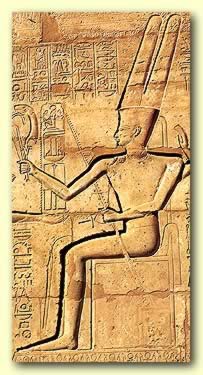
Amen-Ra
This is a iconic picture chiseled in stone is anthropomorphic image of the neteru Amen-Ra. There is hieroglyphic statement, the MeduNeter to the left and overhead.
"The word just means Egyptian hieroglyphs was a formal writing system used by the ancient Egyptians that contained a combination of logographic and alphabetic elements. A Logograms are commonly known also as "ideograms" or "hieroglyphics", which can also be called "hieroglyphs". It is a meaningful measure of speech. The word hieroglyph comes from the Greek adjective ἱερογλυφικά (hieroglyphiká), a compound of (hierós 'sacred') and γλυφικός (glyphikós 'engraved'; see glyph)." Sacred Engravings.
A hieroglyph is an engraved carving. The words used are called Medu Neter, which means Sacred Writing or Writing of the Divine.
"Finally, we may note that the word Amen occurs not infrequently in early Christian inscriptions, and that it was often introduced into anathemas and Gnostic spells. Moreover, as the Greek letters which form Amen according to their numerical values total 99 (alpha=1, mu=40, epsilon=8, nu=50), this number often appears in inscriptions, especially of Egyptian origin, and a sort of magical efficacy seems to have been attributed to its symbol." (Catholic Encyclopedia Vol. 1; 1907)
Amen means hidden. The name Amen can be read Amun and Amon since there are no vowels in the Egyptian or Hebraic languages and all three variations are the same. The concept of Amen is that he is hidden but everywhere although you can not see him. Amen is like breath and provides the spirit for all creation. His power extends to the ends of the universe. He is the reason all things exist. He is also called: "He who abides in all things". Amen can be connected to Ra, Min, Mut, Taurus the Bull or the astrological sign of Aries the Ram.
We see Amen with a the feathered crown in the human or anthropomorphic form:
![]()
Amen/Amun
"Another frequent image of Amun shows him in human form, with two tall plumes on top of his head, seated on a throne, and he is wearing a short skirt. On top of his crown are two tall plumes, signifying him as a sky deity, and it is said that he was as invisible as the wind."
He is also holding the sign of life the Ankh and the beard and staff of a ruler. So, what does this picture say to us when we look at it without fear or preconceived notions? What did the people who drew or rather carved this picture in stone want us to understand and remember?
Amen the hidden sit on the throne. The Throne is a square representing Maat and the seat of all Creation, the seat of justice, and right and wrong. [Maat is truth, order, law, morality and justice and is pictures as female Her counterpart is Thoth, represented by the masculine. "He was considered the heart and tongue of Ra as well as the means by which Ra's will was translated into speech."]
The double feathers on his head also resembles the balance which relates back to Maat, and some say it is the spiting of the consciousness when it comes into the body.
When we see this image we must think of the Hidden One who is in everything and sits on the seat of Creation, ruling with justice, order and truth, well balance as Creator and sustainer of the Universe.
Please, tell me how is that different from what we were taught in Christianity or Islam, or any other religious practice?
Let is take a look at a combination of Anthropomorphic and Zoomorphic.
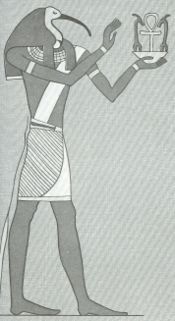 This is Thoth or Tehuti. As we saw above his is
the attribute associated with speech, the will of Ra. Ra being the
attribute of the revealed God, the only image large enough in the heavens
associated with the power or the Unseen God
This is Thoth or Tehuti. As we saw above his is
the attribute associated with speech, the will of Ra. Ra being the
attribute of the revealed God, the only image large enough in the heavens
associated with the power or the Unseen God
"His roles in Egyptian mythology were many. Thoth served as a mediating power, especially between good and evil, making sure neither had a decisive victory over the other. He also served as scribe of the gods, credited with the invention of writing and alphabets (ie. hieroglyphs) themselves. In the underworld, Duat, he appeared as an ape, A'an, the god of equilibrium, who reported when the scales weighing the deceased's heart against the feather, representing the principle of Ma'at, was exactly even.
Tehuti with the ibis head, picks through knowledge to get at the tender morsels. He does not just grab and go, he is specific, systematic and just.
The ancient Egyptians regarded Thoth as One, self-begotten, and self-produced. He was the master of both physical and moral (ie. Divine) law, making proper use of Ma'at. He is credited with making the calculations for the establishment of the heavens, stars, Earth, and everything in them. Compare this to how his feminine counterpart, Ma'at was the force which maintained the Universe. He is said to direct the motions of the heavenly bodies. Without his words, the Egyptians believed, the neteur/powers would not exist. His power was almost unlimited in the Underworld and rivaled that of Ra and Osiris."
Here is another picture of Tehuti
sitting on the square.
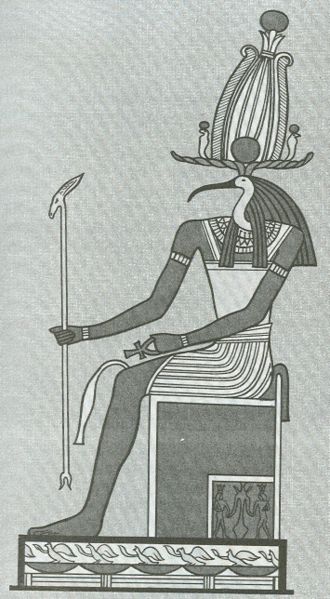 Does
that mean Tehuti and Amen are in conflict? No, just as Earth, Wind and Fire are
not in conflict. Amen is a representation or an attribute or a Anthropomorphic
picture our ancestors used to explain a higher thing, to make them
understandable if you had the keys to understand. Here on Tehuti head is a crown
with the two feather, and the image of Ra [sun] as he sits on the square with
the ankh and staff in his hand.
Does
that mean Tehuti and Amen are in conflict? No, just as Earth, Wind and Fire are
not in conflict. Amen is a representation or an attribute or a Anthropomorphic
picture our ancestors used to explain a higher thing, to make them
understandable if you had the keys to understand. Here on Tehuti head is a crown
with the two feather, and the image of Ra [sun] as he sits on the square with
the ankh and staff in his hand.
Here is a biblical example of two things representing the power of God.
"However, when he, the Spirit of true knowledge, has come, he will be your guide into all true knowledge: for his words will not come from himself, but whatever has come to his hearing, that he will say: and he will make clear to you the things to come." John 16:13
"And I [Jesus] will ask the Father [invisible God], and he will give you another Counselor to be with you forever—the Spirit of truth. The world cannot accept him, because it neither sees him nor knows him. But you know him, for he lives with you and will be [a] in you. John 14:16-17.
We think nothing about the imagery of the Father, Son and Holy Spirit, we see no conflict in that African concept. We see them as a manifestation of the One. No? Well, these are the doctrines agreed upon before we entered what Christianity.
The Apostle's Creed
I believe in God, the
Father Almighty,
the Creator of heaven and earth,
and in Jesus Christ, His only Son, our Lord:
Who was conceived of the Holy Spirit,
born of the Virgin Mary,
suffered under Pontius Pilate,
was crucified, died, and was buried.
He descended into hell.
The third day He arose again from the dead.
He ascended into heaven
and sits at the right hand of God the Father Almighty,
whence He shall come to judge the living and the dead.
I believe in the Holy Spirit, the holy *catholic church,
the communion of saints,
the forgiveness of sins,
the resurrection of the body,
and life everlasting.
Amen.
There's that pesky word again Amen!
Here is another Creed:
Nicene Creed
I believe in one God, the Father Almighty, Maker of heaven and earth, and of all things visible and invisible.
And in one Lord Jesus Christ, the only-begotten Son of God, begotten of the Father before all worlds; God of God, Light of Light, very God of very God; begotten, not made, being of one substance with the Father, by whom all things were made.
Who, for us men and for our salvation, came down from heaven, and was incarnate by the Holy Spirit of the virgin Mary, and was made man; and was crucified also for us under Pontius Pilate; He suffered and was buried; and the third day He rose again, according to the Scriptures; and ascended into heaven, and sits on the right hand of the Father; and He shall come again, with glory, to judge the quick and the dead; whose kingdom shall have no end.
And I believe in the Holy Ghost, the Lord and Giver of Life; who proceeds from the Father and the Son; who with the Father and the Son together is worshipped and glorified; who spoke by the prophets.
And I believe one holy catholic and apostolic Church. I acknowledge one baptism for the remission of sins; and I look for the resurrection of the dead, and the life of the world to come. Amen.
An there it is again Amen. He image of the Hidden who is seated in the heavenlies as king of all. In him the two consciousness' converge and sit upon
the set of righteous, justice and truth. Here is yet another Creed
The Athanasian Creed
Whosoever will be saved,
before all things it is necessary that he hold the catholic faith; Which faith
except every one do keep whole and undefiled, without doubt he shall perish
everlastingly.
And the catholic [universal] faith is this: That we worship one God in
Trinity, and Trinity in Unity;
Neither confounding the persons, nor dividing the substance
For there is one Person of the Father, another of the Son and another of the
Holy Spirit.
But the Godhead of the Father, of the Son, and of the Holy Spirit is all one,
the glory equal, the majesty co-eternal.
Such as the Father is, such is the Son and such is the Holy Spirit.
The Father uncreate, the Son uncreate, and the Holy Spirit uncreate.
The Father incomprehensible, the Son incomprehensible, and the Holy Spirit
incomprehensible.
The Father eternal, the Son eternal, and the Holy Spirit eternal.
And yet they are not three eternals, but one eternal.
As also there are not three uncreated nor three incomprehensibles, but one
uncreated and one incomprehensible.
So likewise the Father is almighty, the Son almighty, and the Holy Spirit
almighty;
And yet they are not three almighties, but one almighty.
So the Father is God, the Son is God, and the Holy Spirit is God;
And yet they are not three Gods, but one God.
So likewise the Father is Lord, the Son Lord, and the Holy Spirit Lord;
And yet they are not three Lords, but one Lord.
For like as we are compelled by the Christian verity to acknowledge every person
by himself to be God and Lord;
so are we forbidden by the catholic religion to say: There are three Gods or
three Lords.
The Father is made of none, neither created nor begotten.
The Son is of the Father alone; not made nor created, but begotten.
The Holy Spirit is of the Father and of the Son; neither made, nor created, nor
begotten, but proceeding.
So there is one Father, not three Fathers; one Son, not three Sons; one Holy
Spirit, not three Holy Spirits.
And in this Trinity none is afore, nor after another; none is greater, or less
than another.
But the whole three persons are co-eternal, and co-equal.
So that in all things, as aforesaid, the Unity in Trinity and the Trinity in
Unity is to be worshipped.
He therefore that will be saved must thus think of the Trinity.
Furthermore it is necessary to everlasting salvation that he also believe
rightly the incarnation of our Lord Jesus Christ.
For the right faith is that we believe and confess that our Lord Jesus Christ,
the Son of God, is God and man.
God of the substance of the Father, begotten before the worlds; and made of
the substance of His mother, born in the world.
Perfect God and perfect man, of a reasonable soul and human flesh subsisting.
Equal to the Father as touching His Godhead, and inferior to the Father as
touching His manhood.
Who, although He is God and man, yet He is not two, but one Christ.
One, not by conversion of the Godhead into flesh, but by taking of the manhood
into God.
One altogether, not by the confusion of substance, but by unity of person.
For as the reasonable soul and flesh is one man, so God and man is one Christ;
Who suffered for our salvation, descended into hell, rose again the third day
from the dead;=
He ascended into heaven, He sitteth on the right hand of the Father, God
Almighty;
From thence He shall come to judge the living and the dead.
At whose coming all men shall rise again with their bodies;
And shall give account of their own works.
And they that have done good shall go into life everlasting, and they that have
done evil into everlasting fire.
This is the catholic [universal] faith, which except a man believe faithfully,
he cannot be saved.
If we believed this, then how do we see a conflict in the Egyptian model in which the catholic church and Protestant church took heir foundation?
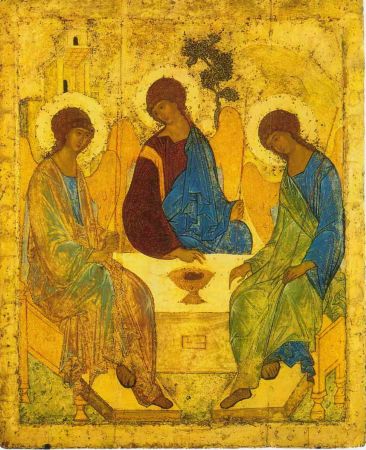
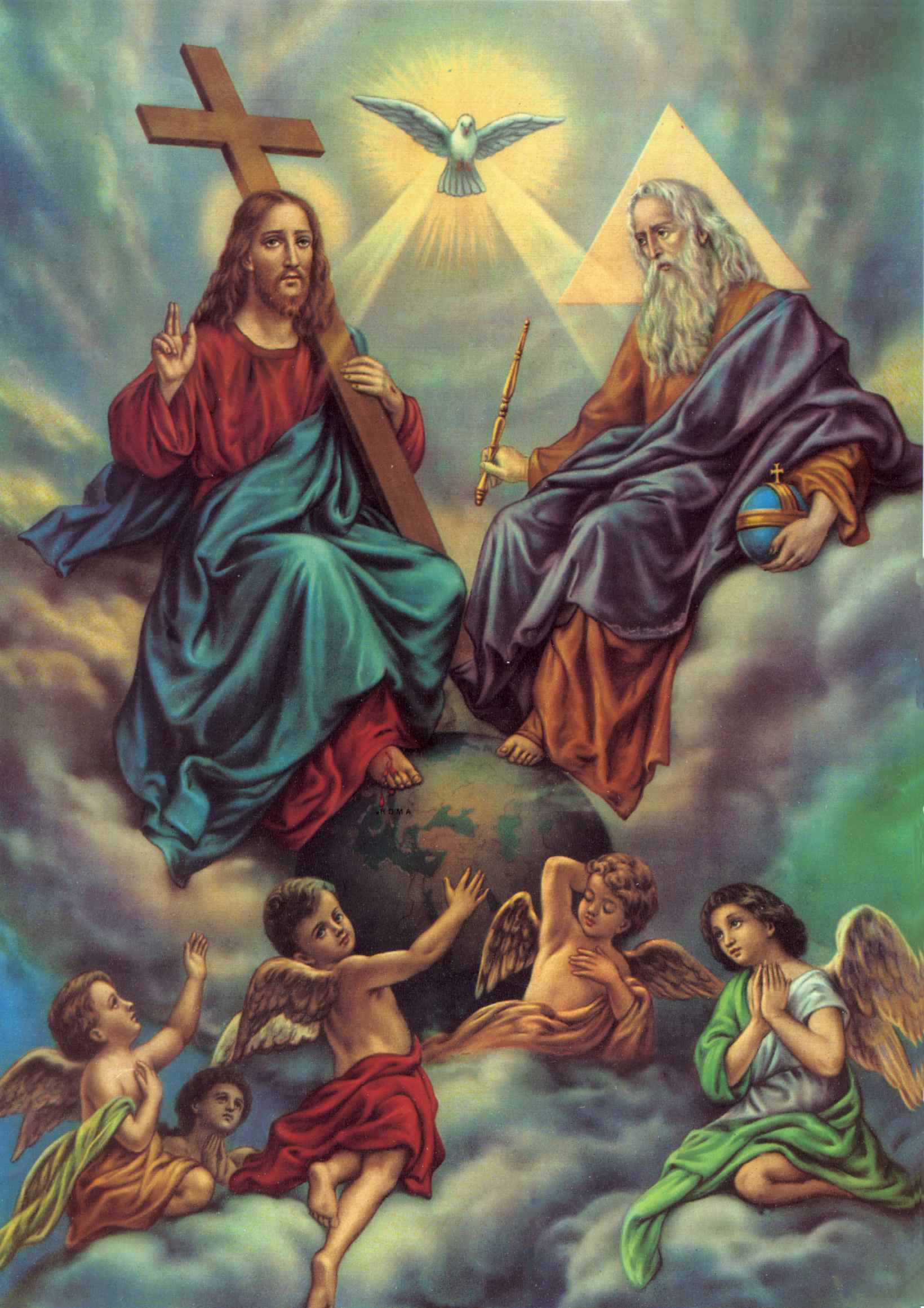
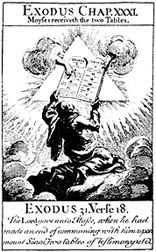
The Trinities with Pyramids
All these pictures tell a story. The first two are Anthropomorphic.
If you notice these have a Sun halo or the Pyramid icon representative a God the Father, the power of God or the Holy Spirit
Notice in figure #2 The Father-God on the right has an orb in his hand and the rays of light coming from the dove, representing the Holy Spirit. In the third picture the table of Moses are coming from God the Father in front of the same pyramid or he is the pyramid.
The next examples are Zoomorphic types in Chritianity.
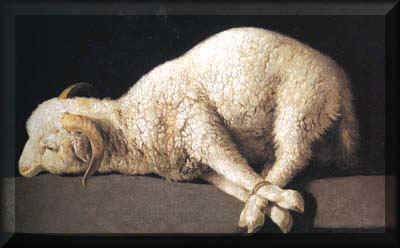
The Lamb of God tied as a sacrifice

Lion of Judah a fierce King
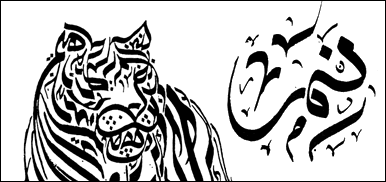
Zoomorphic type in Islam
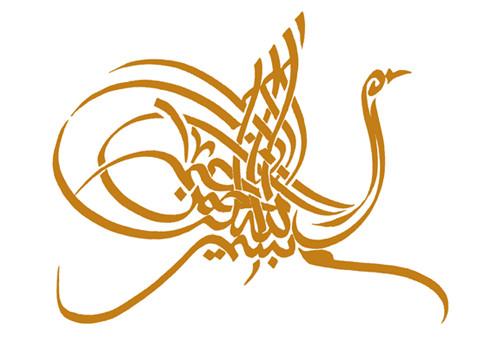
Tell me why if it easier to accept these iconic symbols than the ones from Africa? The Christian, Islamic, and even Hinduisms iconic symbols are based in African religion. Here is an example of the iconic and zoomorphic form of Ganesha. Honestly the first time look at this , I cringed because it was foreign to me. It was not until I understood the symbols that I could look on to comprehend what was being conveyed. A picture is worth 1000 words.

"Although he is known by many attributes, Ganesha's elephant head makes him easy to identify. Ganesha is widely revered as the Remover of Obstacles and more generally as Lord of Beginnings and Lord of Obstacles (Vighnesha, Vighneshvara), patron of arts and sciences, and the deva [divine power] of intellect and wisdom. He is honored at the start of rituals and ceremonies and invoked as Patron of Letters [learning] during writing sessions. Several texts relate mythological anecdotes associated with his birth and exploits and explain his distinct iconography."
Ganesha's head symbolizes the Atman or the soul, which is the
ultimate supreme reality of human existence, and his human body signifies
Maya or the earthly existence of human beings.
The elephant head
denotes wisdom and its trunk represents Om, the sound symbol of cosmic reality.
In his upper right
hand Ganesha holds a goad, which helps him propel mankind forward on the eternal
path and remove obstacles from the way. The noose in
Ganesha's left hand is a
gentle implement to capture all difficulties.
The broken tusk that Ganesha holds like a pen in his lower right hand is a
symbol of sacrifice, which he broke for writing the Mahabharata.
The rosary in his other
hand suggests that the pursuit of knowledge should be
continuous.
The laddoo (sweet) he holds in his trunk indicates that one must discover the sweetness of the Atman.
His fan-like ears convey that he is all ears to our petition.
The snake that runs round his waist represents energy, in all forms.
And he is humble enough to ride the lowest of creatures, a mouse.
Here is another rendition:
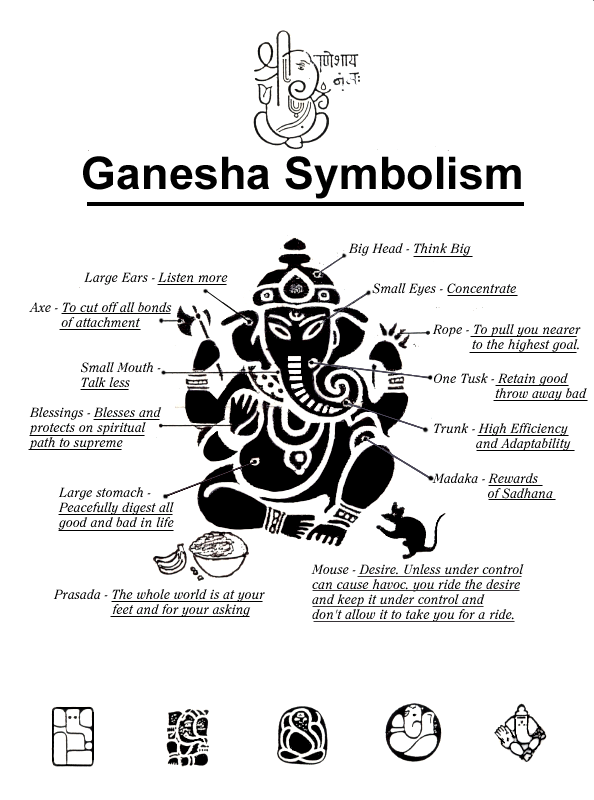
Ganesha

Horus with falcon head, as priest ministers in song. Horus is one of the most ancient deities of the Ancient Egyptian religion, who appears in his earliest form in late Predynastic Egypt. Represented as a falcon, his name is believed to mean 'the high' or 'the far off'[1] and his earliest connections are to the sky and kingship, derived from being the son of Hathor or Nut, as a sun god. Horus was usually represented as a man with a falcon's head. One important association is the Eye of Horus which was an Egyptian symbol of power (first identified with Wadjet and seen on images of his mother, Hathor, as she was emerging from the reeds) and of the offerings made to the god Osiris and by extension, to all of the dead. The right eye is the sun and the left is the moon.
Come let us reason together we all came from or was heavily influenced by Africa. Some stayed and others settled around the world. As we traveled the farther away from our mother we went the more or icons changed. It there was not an Ibis bird in India to related and pass on the story, then another animal would take its place. Soon the long trunk of the elephant was replaced by the long beak of the Ibis. each meaning wisdom and methodical picking of information form life. each a teacher of wisdom. One was Thoth and the other Ganesha.
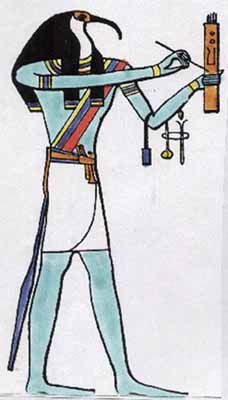
Thoth/Tehuti
He was considered the heart and tongue of Ra as well as the means by which Ra's will was translated into speech. He has also been likened to the Logos of Plato and the mind of God. In the Egyptian mythology, he has played many vital and prominent roles, including being one of the two gods (Ma'at) who stood on either side of Ra's boat. He has further been involved in arbitration, magic, writing, science, and the judging of the dead.
Remember, the Logos was the Greek word for the word. We got that from them, who go it from Egypt!
Logos (Greek λόγος) is an important term in philosophy, analytical psychology, rhetoric and religion. It derives from the verb λέγω legō: to count, tell, say, or speak.The primary meaning of logos is: something said; by implication a subject, topic of discourse or reasoning. Secondary meanings such as logic, reasoning, etc. derive from the fact that if one is capable of λέγειν (infinitive) i.e. speech, then intelligence and reason are assumed.
Its semantic field extends beyond "word" to notions such as "thought, speech, account, meaning, reason, proportion, principle, standard", or "logic". In English, the word is the root of "logic," and of the "-ology" suffix (e.g., geology).
Here the Logos is used in translations:
Logos is usually translated as "the Word" in English Bibles such as the KJV.
Gordon Clark (1902 - 1985), a Calvinist theologian and expert on pre-Socratic philosophy, famously translated Logos as "Logic": "In the beginning was the Logic, and the Logic was with God and the Logic was God." He meant to imply by this translation that the laws of logic were contained in the Bible itself and were therefore not a secular principle imposed on the Christian world view.
The notorious question of how to translate logos is topicalised in Goethe's Faust, with Faust finally opting for "deed, action" (Am Anfang war die Tat).
Some Chinese translations have used the word "Tao (道)".[citation needed]
The term Logos also reflects the term 'dabar' Yahweh" ("Word of God") in the Hebrew Bible.
In his book, "Zero, the Biography of a Dangerous Idea." Charles Seife notes that the Greek word for 'ratio' was 'logos'.Thus the translation of John 1:1 reads:
"In the beginning, there was the ratio, and the ratio was with God, and the ratio was God."
Now that's so interesting stuff!
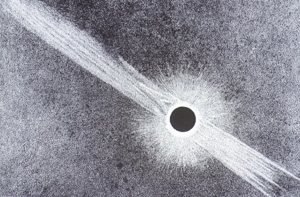
Who was the Sun of Righteousness and its Image?
"It is not until the Fourth Century that the idea of celebrating occasions in the earthly life of our Lord started to become popular. Much of this is due to the Church of Jerusalem. Special celebrations which were devised on the actual or supposed sites of the events of the life of Christ lent themselves particularly well to the celebration of historical remembrances. Thus interest developed in where Jesus was born, where He grew up, where He performed His miracles, etc.
It is to the Church of Rome, however, that we must give the credit for the origins of the feast of the birth of Christ. But on what was this feast based and why was December 25th chosen as the day for its celebration?
The actual historical facts surrounding the birth of Christ are clouded in mystery. No one really knows when Jesus was born. Only certain facts can be deducted from the biblical account and from history. For one thing, Jesus was definitely born in B.C. (Before Christ!). This is known because Herod the Great died in 4 B.C., and Herod figures in the account of the Nativity given by St. Matthew. Jesus was definitely not born in winter. St. Luke mentions that the shepherds were staying out in the pasture land with their flocks, an event that does not take place in winter. We must look elsewhere for the origin of the late December celebration of the Nativity.
We find the origin of the winter feast of the Nativity not in the historical facts available concerning the birth of Christ, but in a curious astronomical phenomenon. In late December we reach the shortest day of the year with more hours of darkness than daylight. From this point the hours of daylight become gradually longer. This observable phenomenon was given a religious significance in the pagan Roman world. It became the feast of Sol Invictus (the Unconquerable Sun). It was popularly celebrated in Rome during the last two weeks of December as Saturnalia. What better time for the Christians to celebrate the coming of the true unconquered "Sun"? Thus the feast of Christmas was born; the celebration of the dawning on the world of the Sun of Righteousness.
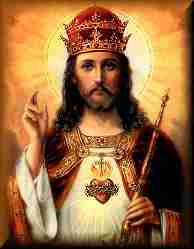
Euro Jesus with Sun as Halo

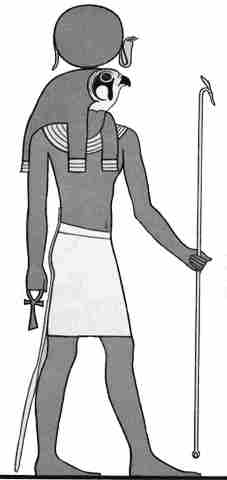
A hawk headed Horus: A hawk, who soars high above the world of humans, seeming to expend no energy in his long hours aloft, and who - far seeing, -can swoop in an instant to capture his prey in sharp talons, became a symbol of kingship.
Falcon: This zootype is shown as a falcon, or as a man with the head of a falcon. In Egyptian, his name is Her - the distant one. Like the good king who sees everything in his kingdom, the hawk is noted for his sharp vision. The sudden stoop of the hawk, as he leaves the distant sky to attack and capture his prey, is like the quick and decisive action of a king in defense of his country.
The sun and snake [time and eternity] as a crown.

George Washington in Egyptian paraphernalia through Freemasonry and the iconic imagery.
Every religion, cultures and nations use Zootype and Anthropomorphic descriptions to make their people remember the deeper truths seen in the image. A picture is worth 1000 words!!!!! We can understand IF we have the keys, but we must not be afraid! The Jews took from the Egyptians , Babylonians and Canaanites. The Christians took from the Jews, Romans and Greeks. And they all borrowed [stole] it from Africa!
African History is the world History!
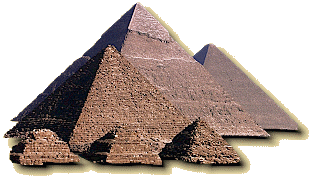
For more please read...
To be continued...
Blessings,
Ekowa
2007-2008